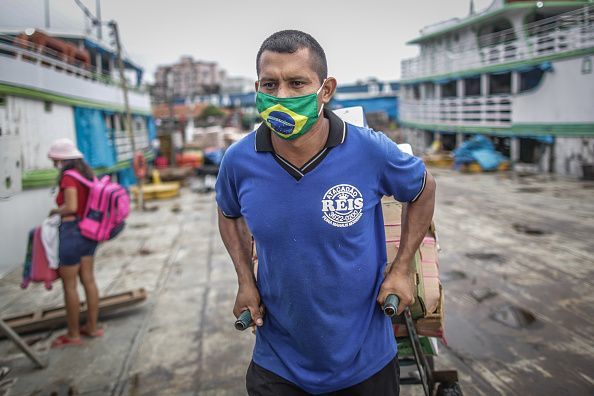
(Bloomberg Opinion) — Latin America’s baleful infrastructure is only too familiar. So, too, are the opportunity costs of years of underinvestment and neglect in ports, roads, water works and the electricity grid. Just ask the almost two thirds of private companies in Argentina, Venezuela and Ecuador that the World Bank says are trying to do business amid chronic power failures.
If the region fails to put more money into infrastructure, Latin America and the Caribbean could forfeit as much as 15% of potential gross domestic product growth over the next 10 years, Inter-American Bank (IADB) manager for infrastructure and energy Jose Agustin Aguerre told me. With the region already forecast to lag behind the rest of the developing world in GDP growth, the misfortunes will likely increase. That’s just one of the takeaways of “From Structures to Services,” a new IADB study on the region’s infrastructure woes. Another is who suffers the most for the debacle.
While all 33 nations in Central and South America and the Caribbean are at risk, it’s clear that the burden of shabby services is not shared equally. The poorest workers and households shoulder an inequitable share of the cost of ramshackle transportation, dirty water, serial power outages and patchy communications. Throw in the coronavirus pandemic, and the plight of those at the bottom is even more dire.
It’s no secret that a robust infrastructure spurs growth. But politicians in the region have traditionally hurled up ill-conceived grand public works and crisscrossed their nations with asphalt and transmission lines to nowhere, too often lining their pockets along the way. (Build and bilk was the driving logic behind Operation Carwash, the Brazilian government procurement scandal.) Latin American and Caribbean companies pay twice as much in bribes on public contracts as do their peers in the wealthier nations of the Organization for Economic Cooperation and Development.
Running and maintaining all that showy hardware is another story, and this is where regional leaders have fallen down. Faulty oversight, lack of competition and corruption lead to inefficiencies that cost Latin America and the Caribbean 0.65% of gross domestic product a year, the IADB found.
Latin America was just recently celebrating a dramatic drop in poverty and the narrowing of one of the world’s widest income gaps. Its targeted cash transfer programs to struggling families became a policy benchmark for fighting poverty without busting welfare budgets. The social gains came to a halt with the end of the commodities boom, and have reversed since the region became the pandemic’s new epicenter. “The most vulnerable populations and individuals are once again being hit the hardest,” United Nations Secretary General Antonio Guterres said last month.
Covid-19 has already laid bare the region’s class-centric digital infrastructure. School closings during quarantine left 154 million Latin American students to study online, according to UNICEF. And yet, at least six in 10 households among the lowest-earning fifth of society lack the fast and reliable web connections needed for remote learning. Compare that to the top fifth of earners, where eight in 10 households have access to fixed high-speed broadband connections at home, the OECD reports.
While half of 15-year-olds in well-heeled homes log on to learning platforms such as Google Classroom and Microsoft Teams, just a fifth of those in poor zones have that ability, the OECD found. Worse, just 45% of students in poorer families have access to home computers, compared with 88% of their peers in higher income schools. In Bolivia, the poorest nation in South America after Venezuela, the government this week canceled the rest of the school year citing the lack of internet connections.
The digital divide goes beyond the classroom. Even for Latin Americans who are wired, just connecting to the internet can be frustrating – and prohibitive. The bottom earning 40% of Latin Americans must shell out around 10% of their monthly wages for a basic – 1 gigabyte – broadband subscription. That’s more than three times what their low-earning counterparts in the richer OECD nations pay for the same service, and five times the baseline target set by the United Nations Broadband Commission for 2025.
Urban mobility is also skewed toward the well-heeled. Consider that the poor, who often live farther from work, spend a greater share of their earnings on shaky public transportation systems. With few options for public transportation, or simply to save on bus and metro fares, some 40% of the lowest earners walk to work or the market, compared with just 10% of the wealthiest commuters.
The poor also shell out dearly for energy, often consuming pricier bottled gas for cooking because the municipal street gas pipelines do not reach their communities. As late as 2016, some 80 million Latin Americans still relied on expensive and polluting fuels such as coal, kerosene and wood.
And despite aggressive expansion of electric lines, many of the humblest homes – including almost half the poor in Panama, 30% in Guatemala and Honduras, and 20% in Bolivia and Peru – have no reliable access to electricity when they are not entirely off the grid. Overall, the bottom half of Latin American and Caribbean society spends almost 30% more on utilities than other developing regions, Aguerre and his research team concluded.
Encouragingly, if the least fortunate are also the big losers in the infrastructure bust, they also stand to gain the most from the sorely needed upgrades. Consider urban mobility. Expanding rapid bus services, which now service 13 countries in the region, could slash urban travel times – by seven minutes in Lima and 11 minutes in Cali – for the lowest income passengers who have the longest commutes.
Raising infrastructure efficiency through smart technology (digital metering, drones and GPS systems) could lower fares, fees and utility rates. Since the poor spend so much of their earnings on such services, they have proportionately more to gain from falling prices. The IADB estimates that a decade of infrastructure efficiency gains could raise the earnings of lowest paid consumers by 28% more on average than the rich. Poor Chileans could see their incomes jump 70% more than those of the rich, while the differential for poor Peruvians would be 40% over the wealthiest.
This presents Latin America with a rare opportunity to reboot the region’s tapped out pipes, cables and bus queues and turn a rout into a win for development and social justice.
This column does not necessarily reflect the opinion of the editorial board or Bloomberg LP and its owners.
Mac Margolis is a Bloomberg Opinion columnist covering Latin and South America. He was a reporter for Newsweek and is the author of “The Last New World: The Conquest of the Amazon Frontier.”
<p class="canvas-atom canvas-text Mb(1.0em) Mb(0)–sm Mt(0.8em)–sm" type="text" content="For more articles like this, please visit us at bloomberg.com/opinion” data-reactid=”44″>For more articles like this, please visit us at bloomberg.com/opinion
<p class="canvas-atom canvas-text Mb(1.0em) Mb(0)–sm Mt(0.8em)–sm" type="text" content="Subscribe now to stay ahead with the most trusted business news source.” data-reactid=”45″>Subscribe now to stay ahead with the most trusted business news source.
©2020 Bloomberg L.P.










